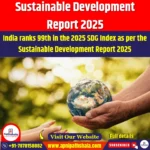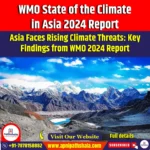GS Paper II: Important International Institutions |
Why in News?
Recently, the World Happiness Report 2025 was published by the Wellbeing Research Centre. This report assesses global happiness based on factors such as economic stability, social support, and life satisfaction.
What is the World Happiness Report?
The World Happiness Report is an annual global publication that measures how satisfied citizens of different countries are with their lives. It assesses happiness levels based on social and economic indicators, analyzing which nations provide a more fulfilling life to their people. The first report was released on April 1, 2012, as part of a high-level United Nations (UN) conference.
- Publisher: The report is published by the Wellbeing Research Centre at the University of Oxford, with contributions from several leading organizations:
- Gallup World Poll: Conducts global surveys to collect data on people’s perceptions of their well-being.
- United Nations Sustainable Development Solutions Network (UN SDSN): Works on sustainable development goals (SDGs) and promotes policies focusing on social well-being.
- Independent Editorial Board: Comprises experts in economics, psychology, and social sciences, who analyze and interpret the data.
- Evaluation Method: The World Happiness Report primarily uses data from the Gallup World Poll, which surveys individuals about their quality of life.
- Cantril Ladder Method: Participants are asked to imagine a ladder with 0 as the worst possible life and 10 as the best possible life. They then rate their own current life on this scale. The rankings are based on a three-year average (for the 2025 report, data from 2022-2024 was used).
- Key Factors for Ranking: The report ranks countries based on six primary indicators:
- GDP per capita (Economic Strength) – Measures a country’s economic prosperity and purchasing power of its citizens.
- Healthy Life Expectancy – Assesses the average lifespan and healthcare quality.
- Social Support – Evaluates the availability of help from family, friends, or government during tough times.
- Freedom to Make Life Choices – Measures citizens’ ability to make independent decisions about their lives.
- Generosity – Examines charitable behavior, donations, and willingness to help others.
- Perception of Corruption – Analyzes transparency and trust in public institutions.
- Purpose of the Report: The World Happiness Report serves several important objectives:
- Guiding Governments: Helps policymakers recognize that economic growth alone is not enough—mental well-being and social trust are equally important.
- Promoting SDGs: Encourages progress toward the United Nations’ Sustainable Development Goals (SDGs) by improving quality of life.
- Comparing Countries: Facilitates comparisons between nations, highlighting best practices in social and economic policies.
- Prioritizing Mental Health: Emphasizes the importance of mental health, social security, and personal freedom.
Key Highlights of the World Happiness Report 2025
- Top-Ranked Countries
- Finland (1st), Denmark (2nd), and Iceland (3rd) secured the top three positions. Their strong social structures, high life expectancy, and transparent governance contribute to their happiness.
- Sweden (4th) and the Netherlands (5th) also ranked highly.
- Costa Rica (6th) and Mexico (10th) entered the top ten for the first time.
- Israel (8th) maintained a high ranking despite ongoing conflicts.
- Declining & Bad-Ranked Countries
- The United States (24th) dropped from 11th in 2012, primarily due to increasing social isolation.
- The United Kingdom (23rd) recorded its lowest happiness level since 2017.
- Afghanistan (147th) remained the unhappiest nation, with severe hardships, especially for women.
- Sierra Leone (146th) and Lebanon (145th) were also at the bottom.
- 19% of young adults worldwide reported having no one to rely on, highlighting declining social support.
India’s Position in the World Happiness Report 2025
- India ranked 118th out of 147 countries.
- Improved from 126th (out of 143) in the previous report.
- Happiness score increased from 4.054 (2021-23) to 4.389 (2022-24).
- India ranked below Nepal (92nd) and Pakistan (109th) despite better economic and governance indicators.
- India’s GDP per capita ($2,480.8 in 2023) is significantly higher than Pakistan’s ($1,365.3), yet Pakistan ranked higher in happiness.
- India has strong social support, with deep-rooted family and community bonds.
- India ranked 10th globally for volunteering.
- 57th in donations and 74th in helping strangers, showcasing a culture of generosity.
Major Reasons for India’s Low Happiness Ranking
- Limited Personal Freedom: India recorded one of the lowest scores in perceived freedom, reflecting restrictions on individual choices in lifestyle, career, and social decisions. Many citizens do not feel free to make crucial life choices due to societal norms, family expectations, and government policies, leading to lower satisfaction levels.
- Social Pressure: Indian society is deeply rooted in familial and cultural values, which often limit personal preferences. Marriage, education, career, and lifestyle choices are heavily influenced by family and societal expectations, restricting individuals from living as they wish. This constant social pressure can lead to stress and dissatisfaction.
- Neglect of Individual Rights: Many legal frameworks in India do not fully promote individual freedom. Strict regulations, censorship, bureaucratic hurdles, and unequal opportunities make it difficult for people to make independent choices. Issues related to employment, entrepreneurship, freedom of expression, and gender equality remain unsatisfactory, negatively impacting citizens’ overall happiness.
UPSC Previous Years’ Questions (PYQs) Question (2016): Which of the following indicators is/are used by IFPRI to prepare the Global Hunger Index report?
Select the correct answer using the codes given below: Answer: (c) Question (2017): Which organization provides the ranking for the ‘Global Gender Gap Index’ for countries worldwide? (a) World Economic Forum Answer: (a) Question (2016): Who publishes the Global Financial Stability Report? (a) European Central Bank Answer: (b) |
Explore our Books: https://apnipathshala.com/product-category/books/
Explore Our test Series: https://tests.apnipathshala.com/









